| Home |
| Acknowledgments |
| Conventions |
| Glossary |
| Maps |
| References |
| Links |
| Articles |
| Thumbnails |
| Species
list |
| Family |
| Next
species |
Additional Photos

underside
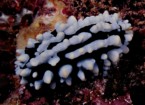
pale

more blue

without yellow
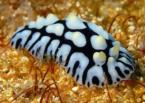
isolated tubercles
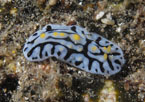
young

feeding?

injured

regeneration error?
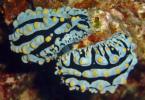
mating

laying eggs
_______________
GALLERY

Phyllidia varicosa Lamarck, 1801
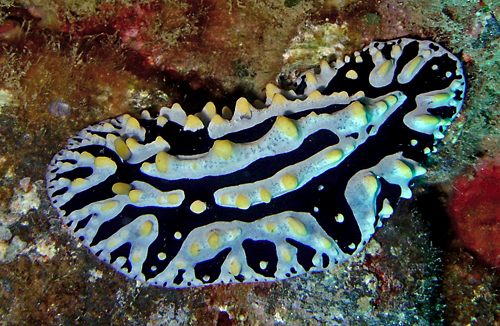
| Maximum size: 102 mm. Identification: This well-known species is elongate-oval with three to six longitudinal, blue-gray ridges composed of smooth, yellow-capped tubercles. The ridges may be broken or continuous. Crescent-shaped, blue-gray areas containing black spots and yellow-capped tubercles are usually present around the mantle margin. The rhinophores are yellow. A medial, black longitudinal stripe is present on the sole of the foot. Occasional animals may have little or no yellow on the tubercles. It may be distinguished from the less common Phyllidia sp. #1 by the dark stripe on its foot and its dorsally located anus. Young animals may sometimes lack the dark line. (Note 1) Natural history: Phyllidia varicosa is probably the nudibranch most frequently noticed by divers. It is a common species usually found in the open on rocks. Occasionally, it may be seen crawling on sand in Halimeda kanaloana beds (usually where some rubble is present) and it's the only phyllidiid regularly found in that habitat. It occurs at moderately protected to highly exposed locations at depths of 1-49 m (3-161 ft). It lays a flat white egg ribbon and may feed on a cream sponge. (Note 2) Recent studies have shown that its toxic secretions may have anti-malarial properties. (Note 3) It may feed on the sponge, Ciocalypta sp. (Note 4) Distribution: Big Island, Maui, Lanai, Molokai, Oahu, Kauai and Niihau: widely distributed in the Indo-Pacific. Taxonomic notes: The name means "dilated veins" in reference to the swollen, vein-like ridges on the notum. In Hawaii, it is commonly referred to as the "scrambled egg nudibranch" or the "fried egg nudibranch." It's also referred to as the "varicose Phyllidia" in Hoover, 1998 & 2006. It was probably first reported from Hawaii in Edmondson, 1946 (as Phyllidia trilineata). (Note 5) Photo: PF: 58 mm: Makena, Maui; July 5, 2008. Observations and comments: Note 1: On Nov. 23, 1023, John Hoover reported that a young animal (about 25 mm) lacked the dark line on its foot. However, other characteristics (including the position of the anal papilla appear comparable to this species (see photo). Note 2: We've observed two individuals in mating position three days in a row spanning at least 48 hours. Note 3: We've observed fish, such as the jack Caranx melampygus, take this species in their mouth and spit it out immediately upon discovering its chemical defense. Their tough bodies allow them to survive such attacks, even when there is injury (see photo). Note 4: It's been reported in various studies of it's secretions as "feeding on the sponge Ciocalypta sp." (a sponge with elongate, cream projections). However, photographic evidence for that seems to be lacking on-line. What evidence does appear on-line shows it associated with a massive white to cream sponge but without obvious feeding damage... Note 5: There's some chance that animals completely lacking yellow pigment (see photos) or with more isolated tubercles (see photo) might turn out to be distinct species. |
| Thumbnails |
Species
list |
Family | Next species | Top |